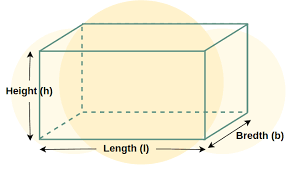
Length, Width, and Height: Dimensions shape how we interact with the world. At their core are length, breadth, and height, simple yet fundamental measurements. Length captures the longest side, like the span of a table.
Breadth or width measures the distance across, perpendicular to length. Height gauges how tall something stands, reaching vertically. Together, they define the size, space, and structure of everything around us, from boxes to buildings. Understanding these three dimensions helps us visualize, design, and organize with precision.
Length
Length represents the longest horizontal measurement of an object. It tells us how long the object is from one end to the other. This dimension is used to determine the maximum extent of an object along a straight line. For example, in a rectangular table, the side that stretches the furthest is considered its length. Length is typically measured in units such as meters (m), centimeters (cm), millimeters (mm), inches (in), or feet (ft), depending on the context and scale of measurement. Length Examples- Measuring Furniture: When buying a sofa, you might measure its length to ensure it fits against your wall. For instance, a sofa might be 2 meters long .
- Road Distances: The distance between two towns or cities is often described in kilometers. For example, "The length of the road from City A to City B is 150 km ."
- Personal Height Measurement: When measuring a person’s height, the measurement represents the length of their body from head to toe.
Width ( Breadth)
Width , also called breadth , is the shorter horizontal measurement of an object, running perpendicular to the length. It measures how wide or broad the object is from side to side.
Width complements the length and is used when describing objects that are not just long but also have a breadth to them. Width is measured using the same units as length, such as meters, centimeters, inches, or feet .Breadth Examples
- Measuring a Table: If a table has a length of 2 meters and a width of 1 meter , the width tells us how broad the table is from side to side.
- Books and Notebooks: The width of a standard book might be 15 cm , while its length might be 25 cm .
- Smartphones: A phone with a width of 7 cm and a length of 15 cm indicates how broad the device is when held horizontally.
Height (Depth)
Height refers to the vertical measurement of an object, indicating how tall or deep it is. In some contexts, particularly when measuring downward, height is referred to as depth . Height is the dimension that runs perpendicular to both length and width. Common units for measuring height include meters (m), centimeters (cm), inches (in), and feet (ft).Height Examples
- Buildings: The height of a skyscraper might be 300 meters , indicating how tall the structure is from the ground to the top.
- Swimming Pools: The depth of a swimming pool might be 2 meters , describing how deep the pool is from the surface of the water to the bottom.
- Children's Growth: A child’s height might be measured at 120 cm , representing their vertical growth.
Width Formula
Width formula is used to calculate the width of an object when volume, length, and height are known. It is calculated as Width = Volume ÷ (Length × Height). This formula helps find the missing width dimension in a rectangular object. Like other dimension formulas, ensure all units are consistent to get the accurate width measurement. This is useful in construction, packaging, and design when one measurement is unknown.
Height Formula
The height formula is used to find the vertical measurement of an object. For example, if you know the volume, length, and width of a box, the height can be found by dividing the volume by the product of length and width. The formula is: Height = Volume ÷ (Length × Width). It is useful when the height is unknown but you have the other dimensions and the total volume of the object.
Height Formula (Repeated)
To find the height when other measurements are known, you can use the formula Height = Volume ÷ (Length × Width). This formula applies to rectangular objects where you know the volume but need to find how tall it is. It helps calculate height accurately and is widely used in geometry and practical problems in daily life. Make sure all measurements are in the same units for correct results.
Length Breadth Height Formula
The length, breadth, and height formula is mainly used to calculate the volume of a rectangular object like a box or room. The formula is Volume = Length × Breadth × Height. All three dimensions must be in the same units, such as meters or centimeters, to get the volume in cubic units. This formula helps determine how much space an object occupies or how much it can hold inside.
Length, Width, and Height Key Differences
To better understand these dimensions, let’s summarize the differences between length, width, and height:| Aspect | Length | Width (Breadth) | Height (Depth) |
|---|---|---|---|
| Definition | Longest horizontal dimension | Shorter horizontal dimension | Vertical dimension |
| Direction | Horizontal, longest side | Horizontal, shorter side | Vertical (upward or downward) |
| Orientation | Along the object's maximum extent | Perpendicular to length | Perpendicular to both length and width |
| Common Units | m, cm, in, ft | m, cm, in, ft | m, cm, in, ft |
| Example Object | Length of a table (e.g., 2 m) | Width of a table (e.g., 1 m) | Height of a table (e.g., 0.8 m) |
| Applications | Measuring distance, furniture, roads | Measuring screens, books, and doorways | Measuring buildings, shelves, water depth |
How Do Length, Width, and Height Work Together?
Length, width, and height work together to define a three-dimensional object’s size, volume, and surface area . For example, a box with dimensions 30 cm × 20 cm × 15 cm is 30 cm long , 20 cm wide , and 15 cm high . These dimensions help calculate:Volume: Volume tells us how much space the object occupies, expressed in cubic units like cubic meters (m³), cubic centimeters (cm³), or cubic inches (in³).
The formula for the volume of a rectangular prism (cuboid) is: = Length × Width × Height
Surface Area: Surface area represents the total area required to cover the object's surfaces, expressed in square units like square meters (m²), square centimeters (cm²), or square inches (in²).
The formula for the surface area of a cuboid is = 2×(Length × Width + Length × Height + Width × Height)Example 1: Volume of a Rectangular Box
Imagine a rectangular box with the following dimensions:- Length: 15 cm
- Width: 10 cm
- Height: 5 cm
- The length (15 cm) tells us how long the box is.
- The width (10 cm) shows how wide it is.
- The height (5 cm) indicates how tall the box stands.
Volume= Length × Width × Height
Substituting the values:
Volume = 15 cm × 10 cm × 5 cm = 750 cm 3
This means the box can hold 750 cubic centimeters of material.Surface Area of a Rectangular Box
To calculate the surface area of the box, use the formula:Surface Area = 2×(Length × Width + Length × Height + Width ×Height)
Substituting the values:Surface Area=2×(15 cm ×10 cm +15 cm ×5 cm +10 cm ×5 cm)
Calculating each term:
15 ×10 = 150 cm 2 15 × 5 = 75 cm 2 10×5 = 50 cm 2Adding them together:
150 + 75 + 50 = 275 cm 2 Now multiply by 2: 2 × 275 = 550 cm 2 The surface area of the rectangular box is 550 square centimeters. This represents the total area needed to cover all six faces of the box.Example 2: Finding the Missing Dimension
The volume of a cuboid is 144 cubic cm. The length is 12 cm, and the width is 2 cm. Find the height.Solution:
Using the volume formula: Length × Width × Height Substituting the values, we get: 144 = 12 ×2 × HeightSimplify:
144 = 24 × Height Height = 144/24Answer: The height of the cuboid is 6 cm .
Practical Applications of Length, Width, and Height
Architecture and Construction
In construction projects, accurate measurements of length, width, and height are essential. For example, when designing a building, architects specify:- The length of walls and beams
- The width of rooms and corridors
- The height of ceilings and structures
Packaging and Shipping
In logistics, understanding dimensions is critical for packaging and shipping. Companies measure the length, width, and height of boxes to:- Calculate the volume for shipping costs
- Ensure products fit into packaging appropriately
- Optimize storage space in warehouses
Interior Design
When arranging furniture in a room, designers consider:- The length of sofas, tables, and shelves
- The width of doorways and walkways
- The height of cabinets, curtains, and wall hangings
| Related Articles | |
| Trapezium | Area of a Circle |
| Prime Numbers | Diameter of a Circle |
| Shapes | Diameter of a Circle |
Length, Width, and Height FAQs
Can an object have length but no breadth or height?
How do changes in one dimension affect the overall volume of an object?
Can two objects have the same volume but different lengths, breadths, and heights?
What happens to the proportions of an object if you double its length, breadth, and height?










